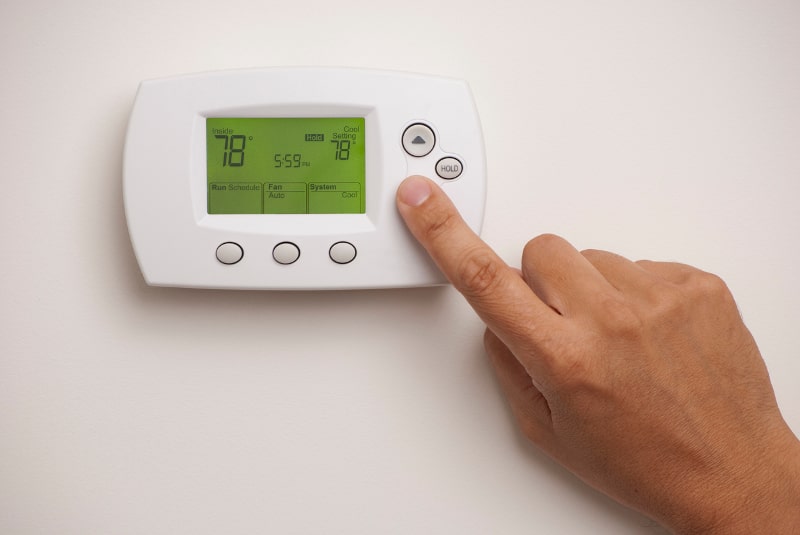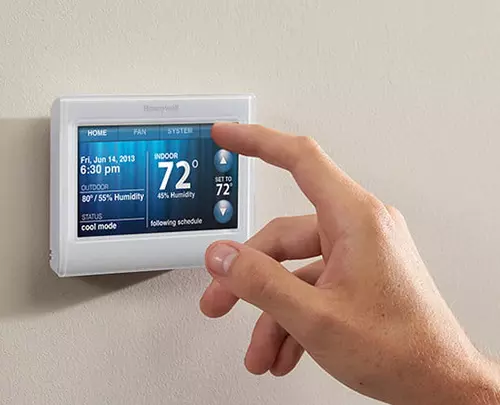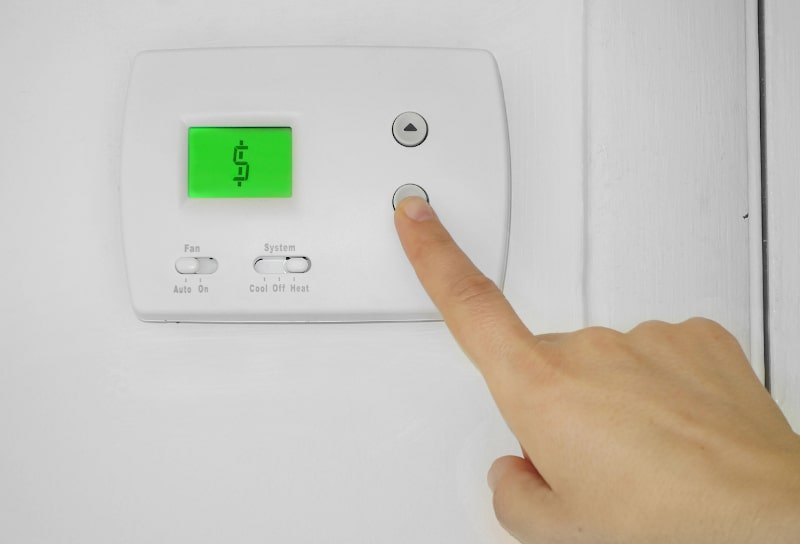Check Best Thermostat Pricing in Amazon
** As an Amazon Associate, I earn from qualifying purchases.
If your home feels too hot or cold despite setting the thermostat, you might need a new one. Irregular temperature readings are another sign.
A thermostat is crucial for maintaining comfortable indoor temperatures. Malfunctions can lead to discomfort and higher energy bills. Common signs include fluctuating temperatures, unresponsive controls, or incorrect readings. If your heating or cooling system frequently cycles on and off, the thermostat might be faulty.
Modern digital thermostats offer improved accuracy and energy efficiency. Upgrading to a new thermostat can enhance home comfort and reduce energy costs. It’s essential to act promptly to avoid unnecessary wear on your HVAC system. Regular maintenance and timely replacement ensure optimal performance and comfort in your home.
- Introduction To Thermostat Health
- Inconsistent Temperatures And Fluctuations
- Thermostat Unresponsiveness
- Skyrocketing Energy Bills
- Frequent Cycling Of The Hvac System
- Outdated Thermostat Technology
- Visible Wear And Tear
- Thermostat Ignores Settings
- Professional Inspection And Diagnosis
- Making The Decision To Replace
- Conclusion: Ensuring Thermostat Efficiency
- Frequently Asked Questions
- Conclusion
Introduction To Thermostat Health
A thermostat is a small device with a big job. It controls the temperature in your home. Keeping it in good health ensures a comfortable living environment. But how do you know when it’s time for a new one? In this section, we will explore the importance and lifespan of a thermostat.
Importance Of A Functioning Thermostat
A functioning thermostat is crucial for your home’s comfort. It helps maintain the right temperature by regulating your HVAC system. Without it, your home could become too hot or too cold. A faulty thermostat can also lead to higher energy bills. An efficient thermostat helps save money on heating and cooling.
Lifespan Of A Typical Thermostat
The average lifespan of a thermostat is about 10 years. Over time, its parts wear out. Older thermostats may become less accurate. Newer models offer more features and better energy efficiency. If your thermostat is over a decade old, it might be time for a replacement.
| Thermostat Type | Average Lifespan |
|---|---|
| Manual Thermostat | 10-15 years |
| Programmable Thermostat | 8-10 years |
| Smart Thermostat | 5-8 years |
Keeping an eye on your thermostat’s performance is key. Regular maintenance can help extend its life. Upgrading to a newer model can provide better comfort and efficiency.

Credit: guardianexperts.com
Inconsistent Temperatures And Fluctuations
Does your home feel warm one minute and cold the next? These temperature swings can be annoying. They often indicate that your thermostat might need replacing. Identifying the root cause is crucial for maintaining comfort and reducing energy bills.
Symptoms Of Temperature Swings
Inconsistent temperatures can manifest in various ways. Here are some common symptoms:
- Uneven Heating or Cooling: Different rooms feel different temperatures.
- Frequent System Cycling: Your HVAC system turns on and off more than usual.
- Incorrect Temperature Readings: The thermostat shows a different temperature than the actual room temperature.
Impact On Comfort And Energy Bills
Inconsistent temperatures greatly affect your comfort. You may feel too hot or too cold, impacting your daily activities. This can disrupt sleep and make relaxing difficult.
Temperature swings also impact your energy bills. An inefficient thermostat makes your HVAC system work harder. This increases energy consumption and costs. A new thermostat can solve these issues, making your home more comfortable and energy-efficient.
Below is a table summarizing the impact:
| Impact | Description |
|---|---|
| Comfort | Inconsistent temperatures disrupt daily life and sleep quality. |
| Energy Bills | Frequent cycling and inefficiency lead to higher energy costs. |
Identifying these symptoms early can help you decide if you need a new thermostat. This can enhance comfort and save money.
Thermostat Unresponsiveness
A thermostat that does not respond can be frustrating. It might not adjust the temperature as expected. This issue can impact your comfort at home. Learning how to spot and fix unresponsiveness is important.
Troubleshooting Communication Issues
Start by checking the batteries. Replace them if they are old. Ensure the thermostat is clean and free of dust. Sometimes, dirt can block the sensors.
Next, verify the thermostat’s display. A blank or dim screen may signal a power problem. Make sure the device is securely attached to the wall. Loose wires can cause issues.
Use the following table to troubleshoot common problems:
| Problem | Possible Cause | Solution |
|---|---|---|
| Blank Screen | Power issue | Check batteries and wiring |
| Unresponsive Controls | Dirty sensors | Clean the thermostat |
| Incorrect Temperature | Calibration needed | Recalibrate the thermostat |
When To Consider Replacement
If the thermostat remains unresponsive, it might be time to replace it. Newer models offer advanced features. They can enhance comfort and energy efficiency.
Consider these signs for replacement:
- The thermostat is over ten years old.
- The display does not work, even after troubleshooting.
- The temperature is always incorrect.
- The system does not turn on or off as expected.
Replacing an old thermostat can improve your home’s climate control. It can also save you money on energy bills.
Skyrocketing Energy Bills
Are your energy bills getting higher each month? This could be a sign that your thermostat is not working efficiently. A malfunctioning thermostat can cause your heating or cooling system to run more than needed. This leads to higher energy usage and increased costs.
Link Between Thermostats And Energy Costs
The thermostat controls your home’s temperature. It tells your HVAC system when to start and stop. If your thermostat is old or faulty, it can misread temperatures. This makes your system work harder, consuming more energy.
A good thermostat keeps your home comfortable and energy-efficient. A bad thermostat can cause your energy bills to rise. It may also lead to uneven heating or cooling in your home.
Replacing an old thermostat with a new, programmable model can save you money. A programmable thermostat adjusts the temperature based on your schedule. This reduces energy waste and lowers your bills.
Evaluating Your Thermostat’s Efficiency
To check if your thermostat is efficient, start by examining your energy bills. A sudden spike in costs may indicate a problem. Also, look for signs like inconsistent temperatures or a constantly running system.
Use the following steps to evaluate your thermostat:
- Set your thermostat to a specific temperature.
- Check if your HVAC system responds correctly.
- Monitor how often your system cycles on and off.
- Compare your current energy bills with past bills.
If your system runs too often or not enough, your thermostat may need replacing. Also, if your HVAC system doesn’t turn on or off at the right times, this is a red flag.
Regular maintenance can help keep your thermostat in good shape. Clean it and check the batteries regularly. This ensures it works efficiently and helps you avoid high energy bills.
Here are some signs you need a new thermostat:
- Your home has uneven temperatures.
- Your energy bills are higher than usual.
- Your HVAC system runs constantly.
- Your thermostat is old or outdated.
A new thermostat can improve your home’s comfort and energy efficiency. It can also save you money on your energy bills.
Frequent Cycling Of The Hvac System
Does your HVAC system turn on and off more frequently than usual? This is known as frequent cycling. It can be a sign that you need a new thermostat. A thermostat tells the HVAC system when to start and stop. If the thermostat is faulty, it may cause short cycling.
Understanding Short Cycling
Short cycling is when your HVAC system turns on and off in quick bursts. This makes the system work harder than it needs to. A working thermostat should keep the system running smoothly. If your system is short cycling, the thermostat might not be working correctly.
Here are some signs of short cycling:
- The HVAC system turns on and off rapidly.
- The home does not reach the desired temperature.
- The system makes unusual noises.
Risks To Your Hvac System
Short cycling can cause serious damage to your HVAC system. It puts extra stress on the components. This can lead to costly repairs or even a full system replacement.
The risks of short cycling include:
| Risk | Impact |
|---|---|
| Increased Wear and Tear | Components wear out faster. |
| Higher Energy Bills | System uses more energy. |
| Reduced Comfort | Home stays too hot or too cold. |
To avoid these issues, consider checking your thermostat. It might be time for a new one.
Check Best Thermostat Pricing in Amazon
** As an Amazon Associate, I earn from qualifying purchases.
Outdated Thermostat Technology
Modern thermostats offer a range of features that old models lack. If your thermostat is outdated, you might not be getting the best performance and efficiency. Upgrading to a newer model can provide several benefits, including energy savings and enhanced comfort.
Comparing Old And New Models
Older thermostats often rely on simple mechanical or electrical systems. They are typically less accurate and harder to program. Many old models require manual adjustments, which can be inconvenient.
Newer thermostats, especially smart ones, offer advanced features. These include programmable schedules, remote control, and learning algorithms. They can automatically adjust to your preferences and habits. This leads to better comfort and energy efficiency.
| Feature | Old Models | New Models |
|---|---|---|
| Accuracy | Low | High |
| Programming | Manual | Automated |
| Control | Local Only | Remote via App |
| Energy Efficiency | Poor | Excellent |
Benefits Of Smart Thermostat Upgrades
Upgrading to a smart thermostat can bring many benefits. One of the key advantages is improved energy efficiency. Smart thermostats can learn your schedule and adjust temperatures automatically. This can lead to significant energy savings.
Another benefit is remote control. You can adjust your thermostat settings from anywhere using a smartphone app. This is particularly useful if you forget to adjust the temperature before leaving home.
Smart thermostats also offer integration with other smart home devices. You can create a connected home environment where all devices work together. For example, your thermostat can communicate with your smart lights and security system.
- Improved energy efficiency
- Remote control via app
- Integration with other smart devices
- Enhanced comfort and convenience
Consider upgrading to a smart thermostat for a more comfortable and energy-efficient home.
Visible Wear And Tear
Visible wear and tear on your thermostat can be an early warning sign that it’s time for a replacement. Over time, thermostats can show signs of aging that affect their performance. By paying attention to these signs, you can avoid sudden breakdowns and ensure your home stays comfortable.
Identifying Physical Damage
Inspect your thermostat for physical damage. Look for cracks on the screen or casing. A cracked screen can make it difficult to read the temperature settings. If the buttons are sticking or not responding, this is another sign of physical damage. Check the wires and connections behind the thermostat. Frayed or exposed wires can be dangerous and lead to malfunction.
| Sign | Potential Issue |
|---|---|
| Cracked Screen | Hard to read settings |
| Sticky Buttons | Difficulty in changing temperature |
| Frayed Wires | Possible short circuit |
When Wear Indicates A Deeper Problem
Sometimes, visible wear can signal deeper issues. For example, a thermostat that frequently loses its settings may have internal problems. If your thermostat is old and showing wear, it may not be as energy-efficient. This can lead to higher energy bills. An older thermostat might also have outdated technology, which can affect your home’s heating and cooling system.
- A thermostat that loses settings could have internal issues.
- Old thermostats may not be energy-efficient.
- Outdated technology can affect system performance.
By identifying and addressing these signs early, you can ensure your thermostat functions properly. This helps maintain a comfortable home environment and can save on energy costs.
Thermostat Ignores Settings
Is your thermostat ignoring your settings? This can be a frustrating experience. You set the desired temperature, but your thermostat does not follow through. This issue can make your home uncomfortable and waste energy.
Common Causes Of Setting Malfunctions
Several issues can cause your thermostat to ignore settings. Here are some common causes:
- Dirty Sensors: Dust can block sensors, making the thermostat read the temperature wrong.
- Dead Batteries: Low or dead batteries can make the thermostat unresponsive.
- Faulty Wiring: Loose or damaged wires can disrupt the signal.
- Software Glitches: Bugs in the thermostat’s software can lead to malfunctions.
Troubleshooting Vs. Replacing
Should you troubleshoot or replace your thermostat? Let’s look at the steps for each option:
| Action | Steps |
|---|---|
| Troubleshooting |
|
| Replacing |
|
If troubleshooting does not fix the issue, it might be time for a new thermostat. A new thermostat can improve your home comfort and save energy.
Professional Inspection And Diagnosis
Sometimes it’s hard to know if your thermostat needs replacing. A professional inspection and diagnosis can help. Experts can identify issues that you might miss. This service ensures your heating and cooling systems work efficiently.
When To Call A Professional
- Inconsistent Temperature: If rooms feel too hot or too cold, it’s time to call a professional.
- Unresponsive Thermostat: If your thermostat doesn’t respond to settings, you need expert help.
- High Energy Bills: A sudden spike in energy costs can signal a thermostat issue.
- Old Thermostat: If your thermostat is over 10 years old, get it checked.
What To Expect During A Thermostat Assessment
During a thermostat assessment, experts follow a detailed process:
- Initial Consultation: The technician will ask about your thermostat issues.
- System Check: They will inspect your HVAC system and thermostat.
- Diagnostic Tests: Various tests ensure all parts function correctly.
- Report Findings: The technician will explain the issue and suggest fixes.
- Recommendations: They may recommend repairs or a new thermostat.
| Step | Description |
|---|---|
| 1. Initial Consultation | The technician will ask about your thermostat issues. |
| 2. System Check | They will inspect your HVAC system and thermostat. |
| 3. Diagnostic Tests | Various tests ensure all parts function correctly. |
| 4. Report Findings | The technician will explain the issue and suggest fixes. |
| 5. Recommendations | They may recommend repairs or a new thermostat. |

Credit: coastalhvac.biz
Making The Decision To Replace
Is your thermostat acting up? You might be wondering if it’s time for a new one. A faulty thermostat can lead to uncomfortable temperatures and higher energy bills. Deciding to replace your thermostat involves a few crucial considerations.
Cost-benefit Analysis
First, let’s look at the cost-benefit analysis. Replacing an old thermostat can save you money in the long run. Old thermostats often cause higher energy bills due to inefficiency. A new, energy-efficient thermostat can reduce these costs.
| Old Thermostat | New Thermostat |
|---|---|
| Higher energy bills | Lower energy bills |
| Inconsistent temperatures | Stable temperatures |
| Limited features | Smart features |
Think about the initial cost of a new thermostat. Prices can range from $20 to $200. Smart thermostats are more expensive but offer better savings. Weigh the benefits against the cost. If your thermostat is more than 10 years old, replacement is often the best choice.
Choosing The Right Thermostat For Your Home
Next, consider choosing the right thermostat for your home. There are several types of thermostats available:
- Non-programmable thermostats: Basic and easy to use.
- Programmable thermostats: Let you set schedules for heating and cooling.
- Smart thermostats: Connect to Wi-Fi and offer advanced features.
Think about your needs. Do you need a simple thermostat or one with advanced features? Smart thermostats can be controlled via smartphone apps. They can learn your schedule and adjust temperatures automatically. This can save you even more on your energy bills.
Make sure to choose a thermostat compatible with your HVAC system. Check the specifications before buying. Some thermostats work with specific systems only.
Conclusion: Ensuring Thermostat Efficiency
A thermostat is the heart of your heating and cooling system. Ensuring it works efficiently saves energy and keeps your home comfortable. Knowing when to replace your thermostat is crucial. This section will help you maintain and monitor your new thermostat.
Maintaining Your New Thermostat
Proper maintenance is key to a long-lasting thermostat. Regularly dust and clean your thermostat. This prevents dirt from affecting its performance. Change the batteries every year to avoid power issues. If your thermostat is hardwired, check for loose connections.
Calibrate your thermostat annually. This ensures it reads the temperature accurately. Follow the user manual for calibration steps. Update the software if your thermostat is smart. Manufacturers release updates to improve performance and add features.
| Task | Frequency |
|---|---|
| Dust and Clean | Monthly |
| Change Batteries | Yearly |
| Calibrate | Yearly |
| Update Software | As released |
Monitoring Performance Over Time
Track your energy bills. A sudden spike can indicate thermostat issues. Listen for unusual noises from your HVAC system. Clicking or buzzing may mean the thermostat is faulty. Check the display for error codes or inconsistent readings.
Test the temperature in different rooms. Use a portable thermometer to compare readings. If there are large differences, your thermostat might be the problem. Stay alert to changes in comfort levels. If your home feels too hot or cold, the thermostat may not be working right.
- Track energy bills
- Listen for unusual noises
- Check the display
- Test temperatures in different rooms
- Stay alert to comfort changes
Keeping an eye on these factors ensures your thermostat remains efficient. Regular checks and maintenance prevent costly repairs and keep your home comfortable.

Credit: www.sobieskiinc.com
Frequently Asked Questions
How Can You Tell If Your Thermostat Is Bad?
A bad thermostat often shows irregular temperatures. It may not reach the set temperature or fluctuate frequently. High energy bills and a constantly running HVAC system are also signs. If the thermostat is unresponsive or displays incorrect readings, it may need replacement.
How Do I Tell If I Need A New Thermostat?
Your thermostat may need replacing if it can’t maintain the set temperature. Frequent temperature fluctuations, unresponsive controls, or increased energy bills are signs. If your HVAC system runs constantly or won’t start, consider a new thermostat. An old, outdated model may also indicate it’s time for an upgrade.
How Do I Test My Home Thermostat?
To test your home thermostat, set it to a specific temperature. Wait for a few minutes. Check if the HVAC system responds correctly. Use a thermometer to verify the room temperature matches the thermostat setting. If there’s a discrepancy, recalibrate or replace the thermostat.
Does A New Thermostat Make A Difference?
Yes, a new thermostat can improve energy efficiency. It provides better temperature control, leading to cost savings.
Conclusion
Recognizing the signs of a failing thermostat can save you time and money. A new thermostat can boost efficiency. Always consult a professional for accurate diagnosis and installation. Stay proactive to maintain comfort and energy savings. Investing in a new thermostat can enhance your home’s overall performance.
Check Best Thermostat Pricing in Amazon
** As an Amazon Associate, I earn from qualifying purchases.


